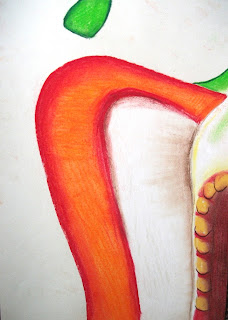For my new Contextual Studies module, I have to update my illustration blog with research areas titled; Design Practice, Design Product and Design Discourse. These include discussing and reviewing certain aspects of the 'art world' such as gallery visits, lectures and inspirational artist work. Any post relating to this particular brief will have DD2000 in the title.
Design Practice; Investigation into design activities related tot he invention planning and design problem solving. Design Practice focuses on people and process across a range of design disciplines and the concept of multi-disciplinary design.
- Review the lectures of TWO practitioners who will deliver visiting lectures to you this year. (600 words)
Design Practice - Ben Tallon
21st January; my illustration class attended a lecture given by Ben Tallon. Ben is a multi-award winning illustrator, designer and Creative- Director who previously graduated from UCLAN and has commissioned illustrations for clients all over the world and exclusively niche projects. The main focus of his lecture was to talk about his work and answer our questions about the industry however he also spent the day at UCLAN to provide us with a brief during our editorial week.
'Personal Illustration'
He firstly spoke to us about his working method and how he became comfortable in the industry. He presented examples of his own art work, giving a short summary about each piece, who the client was, what he enjoyed and what he was inspired by. His work is quite contemporary, I find he combines line techniques I've seen before with fresh ideas and compositions, for example the layering techniques used in 'personal illustration'. His talk was mainly helpful due to the fact that he was comfortable in his own style, and eventually after trial and error found certain clients that his work really linked well with. It was also relevant to the work we were producing ourselves during our editorial week. It was refreshing to hear a personal review on someone who was involved in the editorial industry, who had developed as he worked within the industry and understood how it worked. He provided us with a glimpse of what art directors look for in a rough and what would be expected of your work. Also he explained what was to be expected of timing and deadlines, for example certain clients set different deadlines for the work needed as Ben explained he could have from three hours to a week to complete one piece.

'Adidas Illustrations'
An aspect of his talk which I found most helpful and reassuring was when Ben explained how he'd made his way into the industry. After much hard work after completing his degree, he rented his own studio and slowly began working with an agent and publications. He encouraged us to continue exploring illustration, even in aspects were not so comfortable in ourselves and explained that time away from illustration can be really motivational because you can be inspired by anything. He also explained how he personally finds it easier to work through amounts of work by taking breaks to refresh yourself, so everything doesn't seem as hectic.
'Lufthansa Airways Illustrations'
When he first left university, he explained that he found it useful to get feedback other practitioners, particularly because it helped deliver samples of his work to clients that would actually be interested, instead of sending all of his work to clients that his style, or particular topics just wouldn't relate to. He also believes that constructive critique can really help improve your personal method of work and style, which I have found useful in the past. He also added that to be successful within the editorial industry, it pays to be quick and decisive in order to meet the deadlines and have a finished piece that you are happy with.
After the lecture, he gave us the final article to illustrate for our editorial brief. This one was from the Big Issue on providing help for certain people who needed it, the homeless, people in debt etc. We had to put a rough together before a group crit at the end of the working day. Ben also spent his time throughout the day by seeing how everyone was getting on in response to the brief and trying to give helpful advice to improve our ideas. Tutors went through each piece, depicting the good aspects and also the areas that needed improvement. It was helpful to have a different opinion, plus as Ben is comfortable in the editorial industry his advice was much appreciated.
You can see all of the responses to this brief on the Preston Illustration blog;
Preston Illustration.
There are several examples of Ben's work throughout this post. The main aspect of his work which I am most attracted to is his ability to hand-craft experimental mark making with drawn typography. I find he has quite an adventurous and playful style particularly within the textured backgrounds of his work. I find his line techniques quite loose, creating a freedom within his illustration. Also in comparison to his backgrounds, the lines create an interesting contrast. I chose particular illustrations that were vibrant with colour.
Word Count; 737.



































